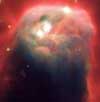"So many of our dreams at first seem impossible, then they seem improbable, and then, when we summon the will, they soon become inevitable. If we can conquer outer space, we should be able to conquer inner space, too." ~ Christopher Reeve
NASA scientists...and the world... have something to celebrate with the pictures from the Hubble Space Telescope...
In our galaxy, 2,500 light-years from Earth, this beautiful pillar of gas and dust called the Cone Nebula was captured by the Telescope's Advanced Camera for Surveys (ACS). The Nebula, located in the constellation Monoceros, is seven light-years long (a light-year = 5.89 trillion miles).
"The ACS is opening a wide new window onto the universe," said Johns Hopkins University astronomer Holland Ford. "These are among the best images of the distant universe humans have ever seen."
Dr. Ford led the seven-year development of the camera, which was installed in March 2002. The $75 million ACS takes 16-million megapixels per shot and has increased Hubble's ability to detect faint stars and galaxies by a factor of ten. Scientists can now look back almost to the start of the universe 13 billion years ago.
NASA's David Leckrone called the panoramic pictures "remarkable, breathtaking. They're everything we expected and more."
"Most new discoveries," observed philosopher Susanne K. Langer, "are suddenly-seen things that were always there."
Named after American astronomer Edwin Hubble, the upgraded $6.9 billion Hubble Telescope was launched aboard the space shuttle Discovery in 1990 and orbits about 360 miles above Earth.
"Even after 12 years of great science and astounding images," raved NASA's chief of space science Edward Weiler, "we haven't seen anything yet."

